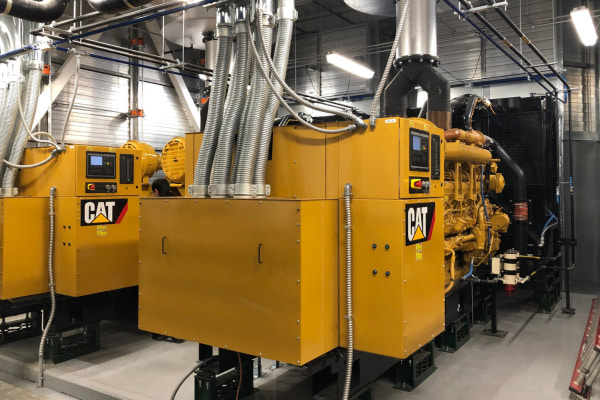The Engineering Difference: 5 Ways Engineers Impact Daily Life
Imagine a building as a living, breathing entity—MEP systems serving as its pulsating heart and intricate veins. Like the silent conductor of a grand symphony, the engineering systems in commercial and residential buildings orchestrate the unseen magic that ensures day-to-day comfort, safety, and more. In celebration of Engineers Week, which is dedicated to increasing awareness around engineers’ important work and increasing interest in the career field, a few of our engineers highlight 5 ways the MEP systems they design impact daily life and society.
1. Enhanced Learning Environments

Neil Gammon, Associate Principal & Sr. Electrical Engineer: Advanced higher education learning environments help foster academic success, innovation, and holistic student development for future workforce readiness. For those programs that are highly specialized and produce essential workers needed for a thriving society, engineers can design MEP systems that ensure a conducive learning environment for students and faculty across disciplines. From air quality and ventilation that supports the precise environmental conditions necessary for laboratories and research facilities to lighting and audiovisual equipment to support information technology, the arts, and multimedia studies, the systems we design as engineers create environments customized to program goals and needs and results in an enriched student learning experience.
…the systems we design as engineers create environments customized to program goals and needs and results in an enriched student learning experience.
Neil Gammon
The University of Wisconsin-Parkside’s conversion of an existing 50-year-old office and teaching building into a new pre-med program building exemplifies how MEP systems can be used to create state-of-the-art teaching spaces for the next generation of doctors, nurses, and surgeons. As their MEP engineers, we used plumbing systems to eliminate the potential for contamination of other water systems from biohazardous materials. We also incorporated a dedicated air handling system that supports the unique air flow and air quality requirements of the gross anatomy space. New lighting and control systems provided a comfortable teaching and learning environment while maintaining adequate light levels for the detailed intricate work of learning the anatomy of the human body. Lastly, we deployed advanced technology systems to transform the teaching spaces into distance and interactive learning spaces accustomed to pre-med program needs, allowing guest instructors to participate from anywhere in the world.
2. Reduced Emissions

Stephanie Riggen, Sr. Mechanical Engineer: As MEP engineers, our impact on daily life is underscored by the crucial need to address greenhouse gas emissions. Buildings of all types are heavily reliant on fossil fuels for electricity, heating, and air conditioning and are therefore significant contributors of greenhouse gas emissions. This allows MEP engineers to play a pivotal role in mitigating climate change; we can deploy targeted strategies within our system designs to help curtail emissions, including the incorporation of energy-efficient HVAC systems such as geothermal heat pumps and Variable Refrigerant Flow (VRF) systems, and utilizing building automation controls, zoning strategies, and renewable energy systems.

The Iowa City School District is an excellent example of a client proactively reducing greenhouse emissions in their future designs, and therefore impacting the everyday lives of its students. As their engineers, we’ve implemented impactful measures, including geothermal HVAC systems, elimination of gas-fired equipment, variable speed drives on fans and pump motors, energy recovery from exhaust air, LED lighting, and lighting controls responsive to daylight sensing. Through these interventions, engineers shape a sustainable future, directly influencing the environmental footprint of structures integral to people’s everyday lives.
3. Comfort

Allison Rowe, Mechanical Project Engineer: Lighting, temperature, sound—these sensory features in buildings can make or break a person’s experience and enjoyment of the space. For low-income populations who need to make the transition to affordable housing, creating a sense of comfort and home is crucial. The Bayview Foundation Development in Madison, Wisconsin had been looking to give their residents a better place to call home for almost a decade. Their existing townhomes and community center were over 50 years old, with little to no infrastructure improvements during that time. When redevelopment funding was approved, Bayview understood the importance of creating a safe and equitable place for their residents to call home. These plans included being intentional about sustainability and energy efficiency to provide longevity in their new buildings and comfort for their residents.
For the Bayview Community Center, this came in the form of a building standard called Passive House, or PHIUS. As the engineering team, we worked closely with the PHIUS consultants to provide full building energy recovery ventilation, a tight thermal envelope with building pressurization, lighting modulation, and zoned temperature control. The result: A building that is extremely well-insulated and quiet, that maintains comfortable temperatures year-round without sacrificing large patio doors to the central green space and expansive windows. These features allow both the staff and residents to gather and cultivate a thriving, supportive community. Even more, the community center also uses significantly less energy than a standard build, allowing Bayview Foundation to put more funds toward their positive and fulfilling programming for residents instead of utility bills.
4. Peace of Mind

Jonathan Gettler, Principal & Sr. Electrical Engineer: Hospitals not only diagnose and treat diseases but also provide a safe and secure place for healing and recovery. That’s why the reliability of building systems that support these functions is so critical to a hospital’s ability to fulfill its purpose for a community. For St. Luke’s Hospital in Cedar Rapids, the hospital experienced many years of growth, but over time, limited improvements to infrastructure threatened to compromise the hospital’s continued success in providing these services in a safe and secure place. In recent years, several generators were starting to malfunction during power outages.

As the MEP engineers for the hospital’s generator improvements project, we designed a new generator plant to replace the old one and installed it while maintaining an active hospital. There were no shutdowns for patients and all areas remained open. Additionally, the new facility was raised to prevent flooding, hardened to survive extreme wind speed, and designed with redundancy for any single-point failures. This investment by the hospital proved to be impeccably timed, too. Completed in the early summer of 2020, the generators were used just weeks later during the catastrophic Derecho, giving the hospital non-stop, reliable power for over a week. A true testament to resilience and peace of mind—and just in the nick of time!
5. Cost-Savings

Adam Bunnell, Associate Principal & Sr. Mechanical Engineer: Accounting for a sizable portion of the cost of constructing a building, we as MEP engineers play an important role in creating cost-effective and efficient designs that not only consider initial costs but also long-term expenses. Prioritizing designs with low life cycle costs, minimizing maintenance and replacement costs, and meeting owner requirements all ensure lower initial costs and significant long-term savings. It’s what I like to call the “and” mindset of the engineer.
Prioritizing designs with low life cycle costs, minimizing maintenance and replacement costs, and meeting owner requirements all ensure lower initial costs and significant long-term savings. It’s what I like to call the “and” mindset of the engineer.
Adam Bunnell
Our MEP work at the Kirkwood Washington County Regional Center demonstrates how the “and” mindset can have a significant impact on the building costs for an owner. Kirkwood Community College’s multiple regional centers work with area K-12 schools, extending skills training from high schools into areas that Iowa communities need. Design Engineers was hired to redesign a prototype building for a new Washington County Regional Center, targeting improved efficiency. When contrasted with the prototype, implementing mechanical designs with the “and” mindset resulted in not only $600,000 less in MEP systems cost during initial construction, but $500,000 in savings over the mechanical system’s lifespan! Our innovative engineering approaches like geothermal heat pumps instead of rooftop units with hot water reheat terminal units and using the “right-sizing” of equipment led to significant savings for the owner. As engineers, we do all we can to advocate for the “and” mindset in our work and this approach illustrates how engineers can positively impact society by considering the broader picture and implementing sustainable solutions.
The Engineering Difference
Whether it’s comfort and peace of mind for building users, cost-savings for building owners, or better learning environments and reduced emissions that impact society and the environment’s wellbeing, MEP systems are truly the silent protagonists within buildings. As engineers, we commemorate their vital role in creating environments that make our world a better place and celebrate the positive impact engineering has on people’s everyday lives.

